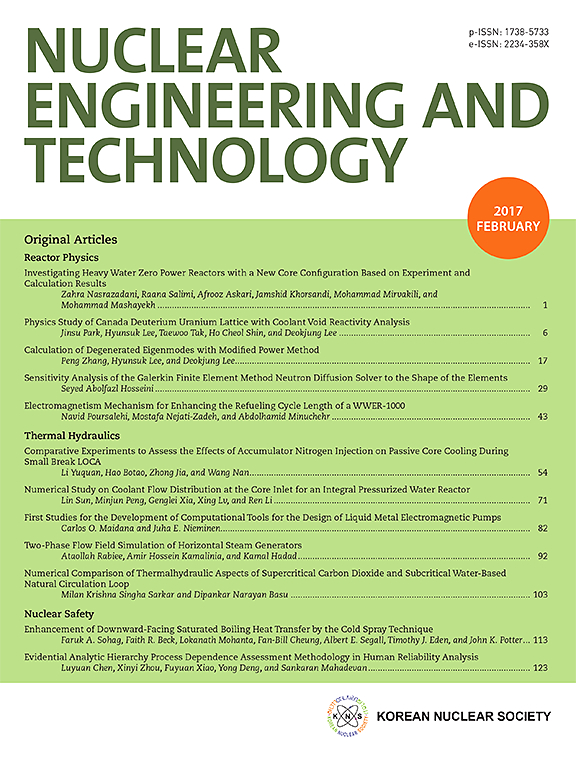Radiological risk and mineralogical analysis of radionuclides in granitic rocks: Environmental insights
IF 2.6
3区 工程技术
Q1 NUCLEAR SCIENCE & TECHNOLOGY
引用次数: 0
Abstract
This study investigates the activity concentrations of naturally occurring radionuclides, particularly 238U, 232Th, and 40K, in granitic rocks from the Gabal Abu Garadi region in Central-Eastern Egypt. Using high-purity germanium gamma-ray spectrometry, these radionuclides were quantified and evaluated their spatial distribution and mineralogical associations. The mean concentrations of 232Th and 238U were found to be 3944 Bq kg−1 and 6554 Bq kg−1, respectively—significantly exceeding global average values reported by UNSCEAR. Radiological hazard indices, including absorbed dose rate (Dair), annual effective dose (AED), radium equivalent activity (Raeq), annual gonadal dose equivalent (AGDE), and excess lifetime cancer risk (ELCR) were subsequently calculated to assess the potential health risks posed by these elevated levels. Principal Component Analysis (PCA) and correlation analyses revealed 238U as the primary contributor to radiological risk in the region. The integration of petrographic and mineralogical studies confirmed the presence of uranium- and thorium-bearing minerals such as uranothorite, thorite, zircon, monazite, and samarskite. The findings highlight the necessity for regulatory oversight and radiation protection measures in areas with similarly enriched geological settings.
花岗岩中放射性核素的放射风险和矿物学分析:环境见解
本研究调查了埃及中东部Gabal Abu Garadi地区花岗岩中天然存在的放射性核素,特别是238U, 232Th和40K的活性浓度。利用高纯度锗伽马能谱法,对这些放射性核素进行了量化,并评估了它们的空间分布和矿物学关联。发现232Th和238U的平均浓度分别为3944 Bq kg - 1和6554 Bq kg - 1,显著超过UNSCEAR报告的全球平均值。随后计算辐射危害指数,包括吸收剂量率(Dair)、年有效剂量(AED)、镭当量活度(Raeq)、年性腺剂量当量(AGDE)和过量终身癌症风险(ELCR),以评估这些水平升高造成的潜在健康风险。主成分分析(PCA)和相关分析表明,238U是该地区辐射风险的主要因素。岩石学和矿物学综合研究证实了含铀和含钍矿物的存在,如铀钍矿、钍矿、锆石、独居石和撒玛石。研究结果强调了在具有类似富集地质环境的地区进行监管和采取辐射防护措施的必要性。
本文章由计算机程序翻译,如有差异,请以英文原文为准。
求助全文
约1分钟内获得全文
求助全文
来源期刊

Nuclear Engineering and Technology
工程技术-核科学技术
CiteScore
4.80
自引率
7.40%
发文量
431
审稿时长
3.5 months
期刊介绍:
Nuclear Engineering and Technology (NET), an international journal of the Korean Nuclear Society (KNS), publishes peer-reviewed papers on original research, ideas and developments in all areas of the field of nuclear science and technology. NET bimonthly publishes original articles, reviews, and technical notes. The journal is listed in the Science Citation Index Expanded (SCIE) of Thomson Reuters.
NET covers all fields for peaceful utilization of nuclear energy and radiation as follows:
1) Reactor Physics
2) Thermal Hydraulics
3) Nuclear Safety
4) Nuclear I&C
5) Nuclear Physics, Fusion, and Laser Technology
6) Nuclear Fuel Cycle and Radioactive Waste Management
7) Nuclear Fuel and Reactor Materials
8) Radiation Application
9) Radiation Protection
10) Nuclear Structural Analysis and Plant Management & Maintenance
11) Nuclear Policy, Economics, and Human Resource Development
 求助内容:
求助内容: 应助结果提醒方式:
应助结果提醒方式:


